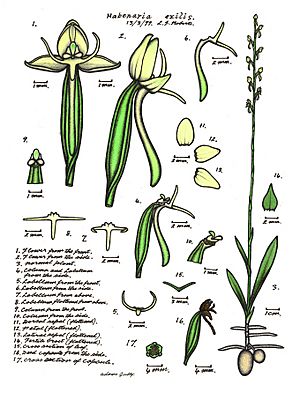Wispy rein orchid facts for kids
Quick facts for kids Wispy rein orchid |
|
|---|---|
 |
|
| Drawing of H. exilis by Lewis Roberts | |
| Scientific classification | |
| Genus: |
Habenaria
|
| Species: |
exilis
|
The Habenaria exilis, also known as the wispy rein orchid, is a special type of orchid. It only grows in a small part of Far North Queensland in Australia. This means it is endemic to that area. This orchid usually has two leaves near its base. It can also grow up to fifteen tiny white flowers.
Contents
What Does the Wispy Rein Orchid Look Like?
The wispy rein orchid is a plant that grows from a tuber, which is like a small underground storage part. It's a perennial herb, meaning it lives for more than two years and has soft stems. It usually has two dark green leaves that stand upright. These leaves are about 20 to 60 millimeters (0.8 to 2.4 inches) long. They are also about 3 to 5 millimeters (0.1 to 0.2 inches) wide.
The Orchid's Flowers
This orchid grows a tall stem, about 200 to 500 millimeters (8 to 20 inches) high. Along this stem, you can find seven to fifteen small white flowers. Each flower is about 8 to 9.5 millimeters (0.3 to 0.4 inches) long. They are also about 5 to 6 millimeters (0.2 inches) wide.
The top part of the flower, called the dorsal sepal, and the petals join together. They form a small hood over the central part of the flower, which is called the column. The dorsal sepal is about 3 millimeters (0.1 inches) long. The side sepals spread out almost flat and are about 4 millimeters (0.2 inches) long. The petals are smaller, about 2 millimeters (0.08 inches) long.
The most interesting part is the labellum, or "lip," of the flower. It's about 3 millimeters (0.1 inches) long and 6 millimeters (0.2 inches) wide. It has three parts, or lobes. The two side lobes are thin like threads and stick out. The middle lobe is shorter and points downwards. The flower also has a white and green spur, which is a tube-like part. It's about 5 millimeters (0.2 inches) long. These orchids usually bloom between January and April.
How the Wispy Rein Orchid Got Its Name
The Habenaria exilis was officially described in 1998. A botanist named David Jones gave it its formal description. He studied a plant sample collected by Lewis Roberts in 1993. This sample was found near a place called Rossville. The description was then shared in a magazine called The Orchadian.
The second part of its scientific name, exilis, comes from a Latin word. It means "thin," "slender," or "meager." This name likely refers to the delicate and wispy look of the orchid.
Where the Wispy Rein Orchid Lives
The wispy rein orchid has a very small home range. It is found only near Rossville in far north Queensland, Australia. It likes to grow in open woodlands where there are also grasses. These areas can sometimes get partly flooded during the summer months.

